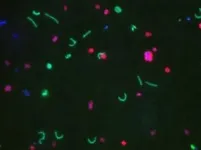(Press-News.org) What’s in a name? A lot, actually.
For the scientific community, names and labels help organize the world’s organisms so they can be identified, studied, and regulated. But for bacteria, there has never been a reliable method to cohesively organize them into species and strains. It’s a problem, because bacteria are one of the most prevalent life forms, making up roughly 75% of all living species on Earth.
An international research team sought to overcome this challenge, which has long plagued scientists who study bacteria. Kostas Konstantinidis, Richard C. Tucker Professor in the School of Civil and Environmental Engineering at the Georgia Institute of Technology, co-led a study to investigate natural divisions in bacteria with a goal of determining a scientifically viable method for organizing them into species and strains. To do this, the researchers let the data show them the way.
Their research was published in the journal Nature Communications.
“While there is a working definition for species and strains, this is far from widely accepted in the scientific community,” Konstantinidis said. “This is because those classifications are based on humans’ standards that do not necessarily translate well to the patterns we see in the natural environment.”
For instance, he said, “If we were to classify primates using the same standards that are used to classify E. coli, then all primates — from lemurs to humans to chimpanzees — would belong to a single species.”
There are many reasons why a comprehensive organizing system has been hard to devise, but it often comes down to who gets the most attention and why. More scientific attention generally leads to those bacteria becoming more narrowly defined. For example, bacteria species that contain toxic strains have been extensively studied because of their associations with disease and health. This has been out of the necessity to differentiate harmful strains from harmless ones. Recent discoveries have shown, however, that even defining types of bacteria by their toxicity is unreliable.
“Despite the obvious, cornerstone importance of the concepts of species and strains for microbiology, these remain, nonetheless, ill-defined and confusing,” Konstantinidis said.
The research team collected bacteria from two salterns in Spain. Salterns are built structures in which seawater evaporates to form salt for consumption. They harbor diverse communities of microorganisms and are ideal locations to study bacteria in their natural environment. This is important for understanding diversity in populations because bacteria often undergo genetic changes when exposed in lab environments.
The team recovered and sequenced 138 random isolates of Salinibacter ruber bacteria from these salterns. To identify natural gaps in genetic diversity, the researchers then compared the isolates against themselves using a measurement known as average nucleotide identity (ANI) — a concept Konstantinidis developed early in his career. ANI is a robust measure of relatedness between any two genomes and is used to study relatedness among microorganisms and viruses, as well as animals. For instance, the ANI between humans and chimpanzees is about 98.7%.
The analysis confirmed the team’s previous observations that microbial species do exist and could be reliably described using ANI. They found that members of the same species of bacteria showed genetic relatedness typically ranging from 96 to 100% on the ANI scale, and generally less than 85% relatedness with members of other species.
The data revealed a natural gap in ANI values around 99.5% ANI within the Salinibacter ruber species that could be used to differentiate the species into its various strains. In a companion paper published in mBio, the flagship journal of the American Society for Microbiology, the team examined about 300 additional bacterial species based on 18,000 genomes that had been recently sequenced and become available in public databases. They observed similar diversity patterns in more than 95% of the species.
“We think this work expands the molecular toolbox for accurately describing important units of diversity at the species level and within species, and we believe it will benefit future microdiversity studies across clinical and environmental settings,” Konstantinidis said.
The team expects their research will be of interest to any professional working with bacteria, including evolutionary biologists, taxonomists, ecologists, environmental engineers, clinicians, bioinformaticians, regulatory agencies, and others. It is available online through Konstantinidis’ website and GitHub to facilitate access and use by scientific and regulatory communities.
“We hope that these communities will embrace the new results and methodologies for the more robust and reliable identification of species and strains they offer, compared to the current practice,” Konstantinidis said.
Note: Tomeu Viver (Mediterranean Institutes for Advanced Studies and Max Planck Institute) and Ramon Rossello-Mora (Mediterranean Institutes for Advanced Studies) also led the research. Additional researchers from the Georgia Institute of Technology, University of Innsbruck, University of Pretoria, University of Las Palmas de Gran Canaria, University of the Balearic Islands, and the Max Planck Institute also contributed.
Citation: Viver, T., Conrad, R.E., Rodriguez-R, L.M. et al. Towards estimating the number of strains that make up a natural bacterial population. Nat Commun 15, 544 (2024).
DOI: https://doi.org/10.1038/s41467-023-44622-z
Funding: Spanish Ministry of Science, Innovation and Universities, European Regional Development Fund, U.S. National Science Foundation.
Writer: Catherine Barzler, Georgia Institute of Technology
END
The who's who of bacteria: A reliable way to define species and strains
2024-03-07
ELSE PRESS RELEASES FROM THIS DATE:
Forbes ranks the University of Colorado Denver | Anschutz Medical campus among America’s best employers
2024-03-07
The University of Colorado Denver | Anschutz Medical Campus is listed as one of Forbes America’s Best Large Employers for 2024.
The 2024 list of “America’s Best Employers” was conducted by Forbes and market research firm Statista, the world-leading statistics portal and industry ranking provider.
“This ranking is meaningful to our organization because the people who work at CU Anschutz drive our success as a leading academic medical campus by providing unparalleled patient care services, being a premier national leader in research and innovation, and fostering a supportive learning ...
NJIT professor trains college counselors to help fight antisemitism
2024-03-07
As data from the Anti-Defamation League shows antisemitism growing on college campuses in recent years and spiking after the Hamas-Israel conflict, a New Jersey Institute of Technology researcher is doing her part to combat the trend by developing a training model that will help prepare mental health professionals who work with Jewish students.
Modern students are hearing people chant slogans without understanding the intentions behind the words, or finding swastikas and other anti-Jewish graffiti on their campuses, but they are not encountering suitably trained counselors and psychologists who understand their ...
For new moms who rent, housing hardship and mental health are linked
2024-03-07
Becoming a parent comes with lots of bills. For new mothers, being able to afford the rent may help stave off postpartum depression.
“Housing unaffordability has serious implications for mental health,” said Katherine Marcal, an assistant professor at the Rutgers School of Social Work and author of a study published in the journal Psychiatry Research. “For mothers who rent their homes, the ability to make monthly payments appears to have a correlation to well-being.”
Housing hardship – missing rent or mortgage payments, moving in with others, being evicted ...
MD Anderson research highlights for March 7, 2024
2024-03-07
HOUSTON ― The University of Texas MD Anderson Cancer Center’s Research Highlights showcases the latest breakthroughs in cancer care, research and prevention. These advances are made possible through seamless collaboration between MD Anderson’s world-leading clinicians and scientists, bringing discoveries from the lab to the clinic and back.
Recent developments at MD Anderson offer clinical insights into a novel treatment strategy for patients with relapsed/refractory acute myeloid leukemia (AML), molecular insights into Burkitt lymphoma development, a therapeutic target to overcome ...
Prepare workers to weather time shocks
2024-03-07
AUSTIN, Texas — Managers can do much to help their workers become more resilient to inevitable time disruptions in today’s workplace, says new research from The University of Texas at Austin.
With intricate supply chains and operations that sprawl across time zones, workplace time disturbances are only increasing. Such temporal disruptions aren’t just inconvenient, says David Harrison, Texas McCombs professor of management professor: They can carry tangible business costs, such as impaired health, increased mistakes, and reduced ...
The health impacts of migrating by sea
2024-03-07
In the four years after the border wall height was increased from 17 feet to 30 feet along the US-Mexican border, drowning deaths of migrants in the Pacific Ocean off the coast of San Diego increased by 3200%, according to a new study published in JAMA. Co-authors Anna Lussier, M.D, Ph.D. student in the University of California San Diego School of Medicine, and Peter Lindholm, M.D., Ph.D., Gurnee Endowed Chair of Hyperbaric and Diving Medicine Research and professor in residence in the Department of Emergency Medicine at UC San Diego School of Medicine, ...
Democratic backslide a threat to free elections globally
2024-03-07
Over half of the 60 countries holding national elections this year are experiencing a democratic decline, risking the integrity of the electoral process, as reported in the latest Democracy Report from the V-Dem Institute at the University of Gothenburg. The worsening election quality is concerning, given the pivotal role elections play in either reinforcing or mitigating the trend of autocratization.
The wave of democratic backsliding, or autocratization, continues to be noticeable, according to the report. 42 countries are autocratizing, and 71 percent of the world’s population now live in autocracies – up from 48 percent ten years ago. There ...
Agriculture: Increasing frequency and scale of mass mortality events among farmed salmon since 2012
2024-03-07
The frequency and scale of mass mortality events — events where large numbers of organisms die in short periods of time — among farmed salmon have increased since 2012, according to a study published in Scientific Reports.
Gerald Singh and colleagues analysed salmon mortality data from Norway, Canada, the UK, Chile, Australia, New Zealand — countries that produced over 92% of the world’s farmed salmon in 2021 — between 2012 and 2022. They identified 865 million instances of salmon mortality during ...
Plant science: Tracing the spread of cacao domestication
2024-03-07
The cacao tree (Theobroma cacao), whose beans (cocoa) are used to make products including chocolate, liquor and cocoa butter, may have spread from the Amazon basin to the other regions of South and Central America at least 5,000 years ago via trade routes, suggests a paper published in Scientific Reports. These findings, based on residues in ancient vessels, reveal how different strains of cacao tree were bred and suggest that cacao products were more widely used among ancient South and Central American cultures than previously thought.
The modern cacao tree — whose scientific ...
Mental health–related outpatient visits among adolescents and young adults, 2006-2019
2024-03-07
About The Study: The findings of this analysis of nationally representative data suggest that youth experienced a significant and sustained increase in mental health burden for over a decade preceding the COVID-19 pandemic, and treatment and prevention strategies will need to address preexisting psychiatric needs in addition to the direct effects of the COVID-19 pandemic.
Authors: Florence T. Bourgeois, M.D., M.P.H., of Boston Children’s Hospital, is the corresponding author.
To access the embargoed study: Visit our For The Media website at this link https://media.jamanetwork.com/
(doi:10.1001/jamanetworkopen.2024.1468)
Editor’s ...


